
Slovechno
This game was run by me at a convention for the two players who had previously not played Red Actions!. I wanted the game to be fairly small and simple, yet have a bit of flavour to it, rather than just a simple slug-fest. Also, by making the game lop-sided I could ensure that it would be played to a conclusion, rather than just drag on into the night.
Introduction
This was given to both sides, and left for any passers-by to read as well. The "research" is straight from Wikipedia.
Poles vs Soviets
Slovechno, Belarussia 1920
With the defeat of the White armies almost complete at the start of 1920, Soviet Russia increased its forces facing Poland. That front had been largely a side issue for Lenin ever since Piłsudski had informed him that he would restrain his troops until the defeat of the Whites.
With the Soviets sending hundreds of thousands of extra troops towards them, the Poles realised that they needed every soldier they could get. One volunteer to their ranks was Stanisław Bułak-Bałachowicz (or, in the Russian Stanislav Bulak-Balakovich), a man with a chequered past fighting the Soviets with the Estonians and White "North-Western Army". He brought with him a motley mixture of men, mostly of Russian or Belorussian origins, and was permitted to recruit in areas captured by the Poles. The Bułak-Bałachowicz Operational Group grew to nearly a division, but always remained a somewhat cut-throat outfit.
The Poles sent them to the Pripet marshes area, where their irregular style was more useful. In June 1920 they were sent to the Mazyr area, just on the Belarussian side of the modern Belarus-Ukraine border, but then the front line.
On June 30 Bułak-Bałachowicz broke through the enemy lines and attacked the village of Slovechno (Sławeczno in Polish) where the supply depot of the Soviet 2nd Rifle Brigade was stationed. That is the action being recreated here.
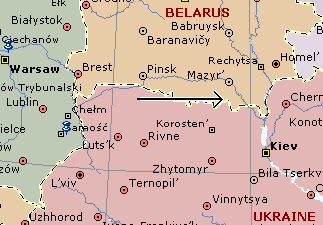
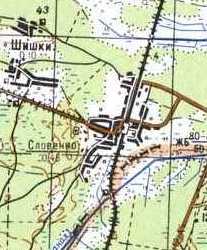
A 1960's era map of Slovechno, right on the Ukrainian border (in pink)
Polish Briefing
Well, youre not a Pole for a start, though you wear their uniform. Actually your men are almost all Russians or Belarussians. Most of them are ex-Red Army deserters or other men displaced by the war.
Special Rules
Discipline is not your strong point, so the following rules apply for this scenario:
– You must lead in person, to set a good example, though not necessarily in the front line. This can be on horse back or foot.
– Any of your units not inside your command radius (12" if visible, 4" otherwise) will exhibit "Mob" like behaviour due to looting every time they:
a) enter a new building;
b) rout an enemy unit in hand-to-hand; or
c) contact an enemy supply wagon.
Looting means that on a d6 = 1 or 2 at the start of their action segment that they will refuse to do anything except defend themselves. This will continue until they throw a d6 = 3+.
Victory Conditions
You are about to attack the village of Slovechno, which contains a Red Army supply base. Your aims are, in order of importance, to:
- capture as many supplies as possible;
- capture any high ranking enemy officers and/or their papers;
- capture the village itself.
- destroy enemy units.
The attack must be conducted as quickly as possible, as reinforcements from surrounding areas can be expected. You hope that the attack is a surprise.
Terrain
The terrain is flat. You will be exiting from the woods to the west of the village, and can deploy anywhere along that edge, except that your artillery must be deployed within 6" of the road.
Any large area of open ground not worked as fields may be boggy: you cannot determine this without entering it.
All buildings count as hard cover.
Your units
Three cavalry squadrons, each of 4 bases. One of these may be designated as your bodyguard unit, and it ignores the looting rule above. Your cavalry is far superior to the enemy cavaly in hand-to-hand combat.
Two infantry battalions, each of three companies, each of 4 bases. Each battalion also has an MG base. Your infantry is superior to the enemy.
Two horse artillery guns. You have 8 rounds of artillery supply for each (unless you capture some enemy 3" shells).
(Total = approximately 500 points using my lists.)
Soviet Briefing
You command the Soviet 2nd Infantry Brigade. Nothing special in terms of quality. You are under a surprise attack by Poles, approaching from the west. Your pickets have raised the alarm and units have rushed to defend the town.
Victory Conditions
You must, in order of priority:
a) escape capture, and prevent secret documents from being captured;
b) prevent the enemy from capturing or destroying your supplies;
c) prevent the enemy from capturing or destroying your armoured train;
d) defend the village;
e) destroy the enemy units.
Terrain
The terrain is flat. Any large area of open ground not worked as fields may be boggy: this will be determined by the umpire at the start of the game (and kept from the enemy).
All buildings count as hard cover.
You must designate (secretly) one building as your HQ and an area in or around the village as the supply dump.
All your units will start in the village, hidden from enemy sight.
Special rules
- Your units suffer –1 to all morale throws until they see an enemy unit suffer a serious reverse.
- It will take 3 moves for your staff to destroy all secret documents.
- It will take d6 + 2 moves for each supply wagon to be prepared for movement. There are six.
- It will take d6 + 4 moves for the train to bring sufficient steam up to be able to move.
Your units
A cavalry squadron of 3 bases. This is inferior to the enemy cavalry.
A regular infantry battalion of three companies, each of 5 bases, with two attached MG bases.
A field gun battery of 2 guns. You have 2 rounds of artillery supply for each gun until they can locate their supply wagon, which will occur on a d6 = 6, whereupon you will have an additional 6 rounds per gun.
An improvised armoured train. It has a field gun carriage at the front which fires at 22.5º to either side, and a MG carriage which fires at up to 60º to the side. The other carriages carry essential supplies.
You may expect reinforcements, mainly infantry, to arrive from surrounding villages within 8 moves. They may come from any direction except the west.
(Total = approximately 250 points, plus the train, plus reinforcements.)
Terrain
The table as seen from the Polish side: it is 1.8m deep by 2.4m wide (6' by 8').
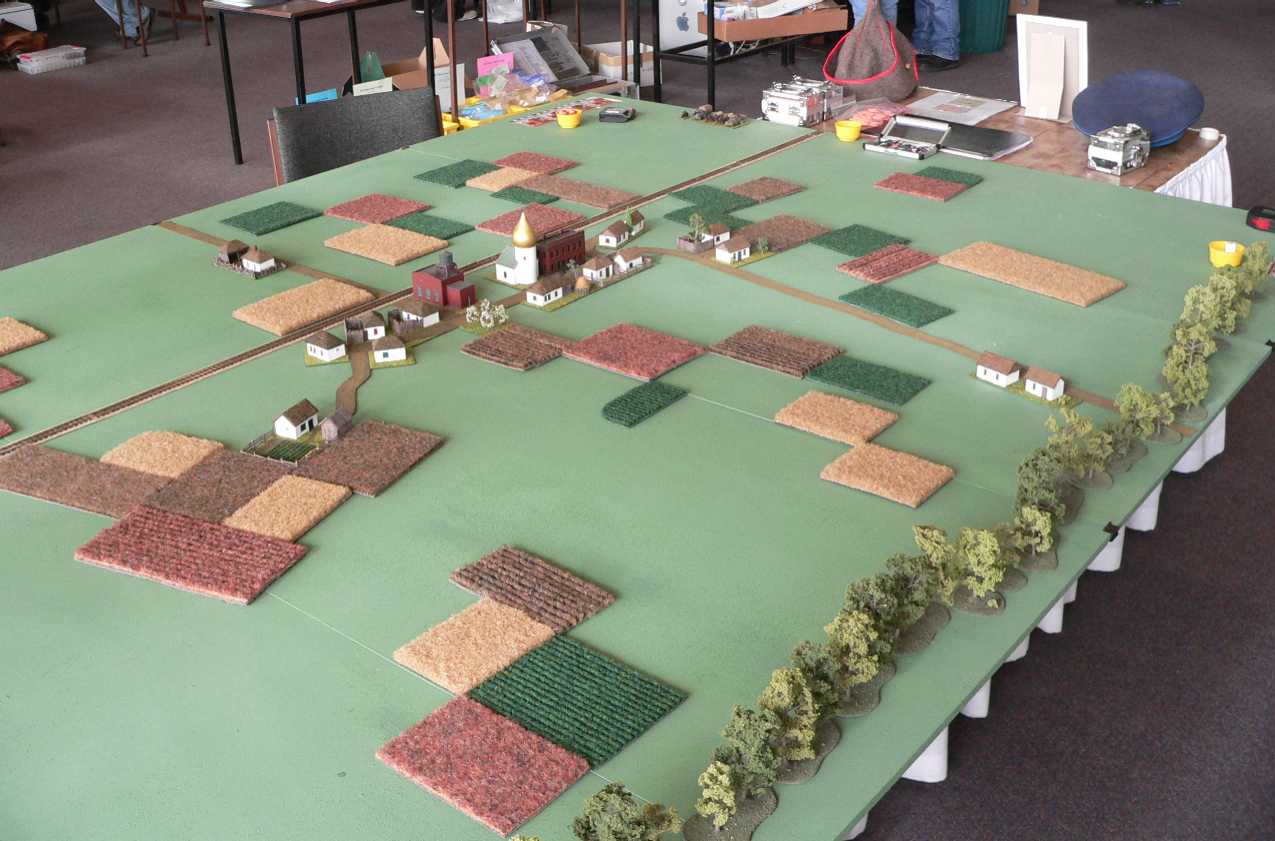
The pictures are reduced in size to fit – they will be larger if saved
Any substantial area not covered in fields was diced for. On a "1" it was boggy: though only the Soviets knew this at the start of the game.
A map of the wider area can be seen here.
Thoughts on how it went
The Soviets have absolutely no chance of holding off the attackers, though this depends a bit on how suited the village is for defence. I found straggling the houses out a bit increased the tactical options for both players. The Polish player needs to be quite aggressive, or the game just relies on him using his superior numbers. That was why I added a time element, by requiring him to try and capture the supply wagons before they could leave.
However d6 + 2 moves for the wagons to get moving was too little. Even if the Pole had been a bit more offensive and a bit luckier, he could not have got around to prevent the wagons leaving in time. I think d6 + 6 would have been better.
The game played for the three hours or so I had planned, which wasn't too bad considering that the players were complete newbies. I finished it by a somewhat arbitrary arrival of Polish reinforcements to cover their withdrawal from the village. That would have been about turn 12.
Pictures in Play
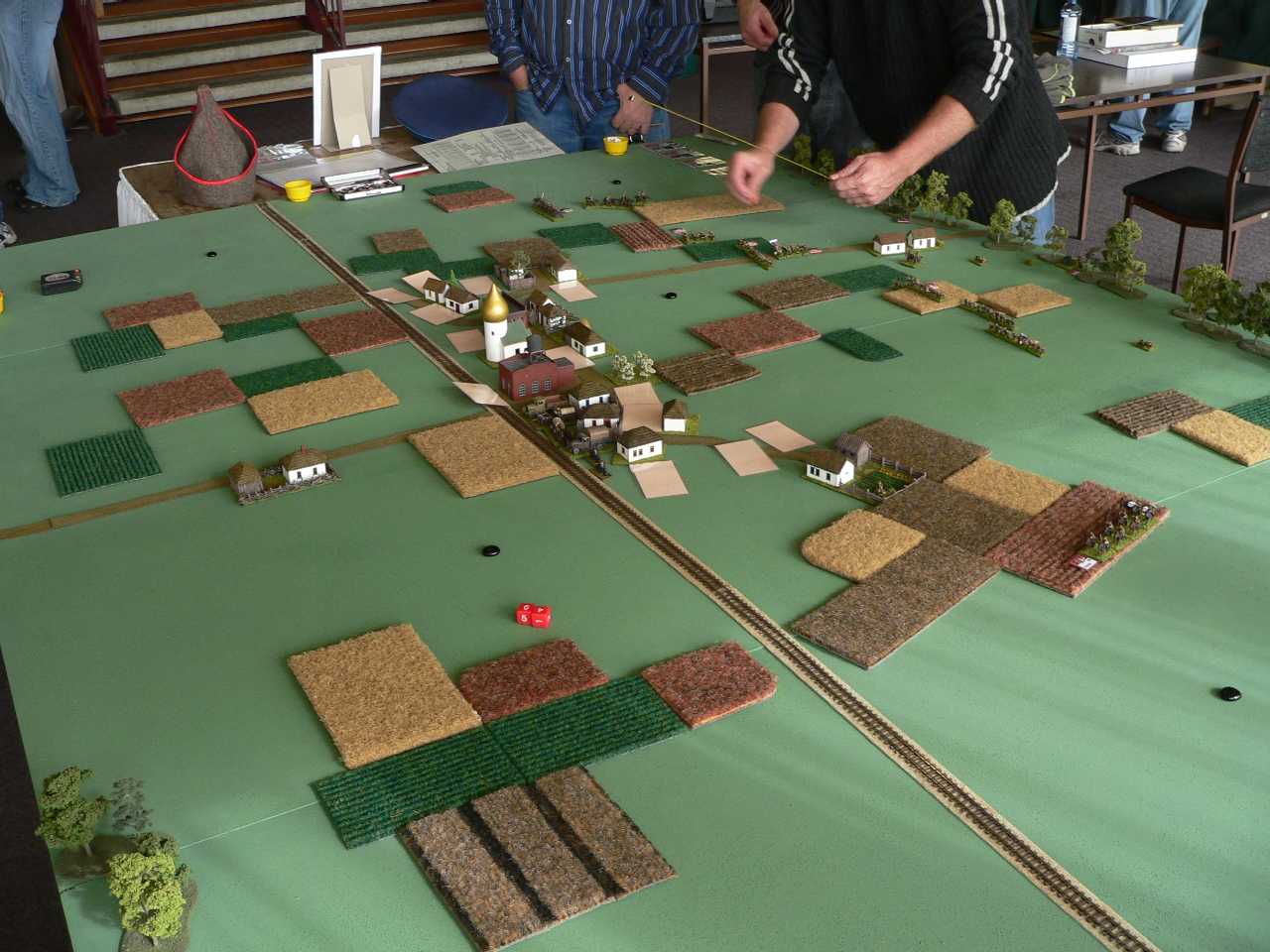
At the far right of the picture the Polish cavalry are attempting to turn the town, to prevent the supplies leaving. The pink cards mark Soviet units not yet declared. Many of them are dummies, to keep the Poles guessing. I find this method adds to the realism of the game, as the attacker has to attack to locate the enemy before engaging him, and also speeds the game up, since the defender deliberately doesn't move or fire units early to keep the attacker in the dark about his actual dispositions.
The small black dots in the fields are turned over to indicate whether that area is boggy or not.
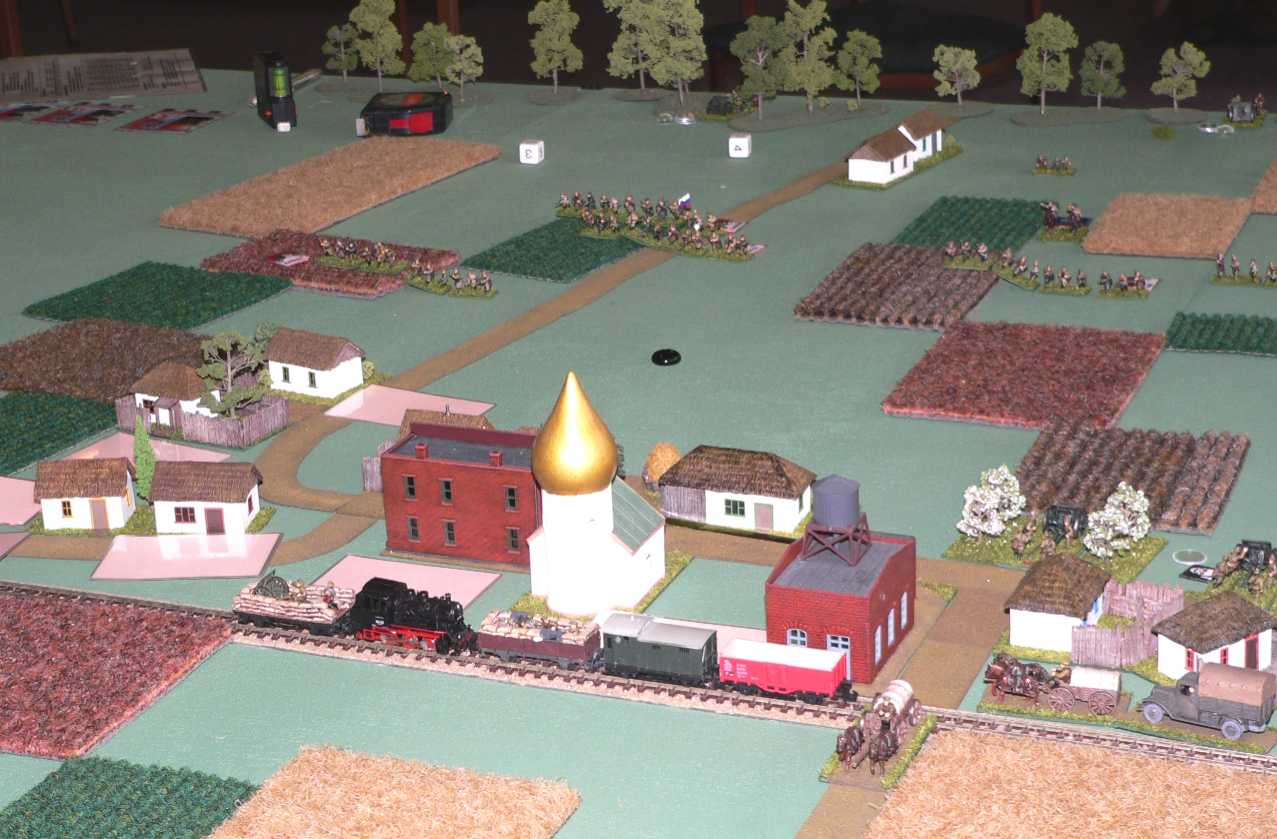
The view from the Soviet side. The transport vehicles can be seen leaving down the road, and the armoured train has now been declared.
